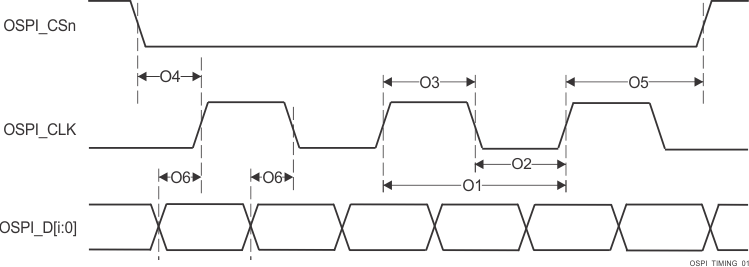JAJSL34G January 2021 – April 2024 AM6411 , AM6412 , AM6421 , AM6422 , AM6441 , AM6442
PRODUCTION DATA
- 1
- 1 特長
- 2 アプリケーション
- 3 概要
- 4 Device Comparison
-
5 Terminal Configuration and Functions
- 5.1 Pin Diagrams
- 5.2 Pin Attributes
- 5.3
Signal Descriptions
- 14
- 5.3.1 ADC
- 5.3.2 CPSW3G
- 5.3.3 CPTS
- 5.3.4 DDRSS
- 5.3.5 ECAP
- 5.3.6 Emulation and Debug
- 5.3.7 EPWM
- 5.3.8 EQEP
- 5.3.9 FSI
- 5.3.10 GPIO
- 5.3.11 GPMC
- 5.3.12 I2C
- 5.3.13 MCAN
- 5.3.14 MCSPI
- 5.3.15 MDIO
- 5.3.16 MMC
- 5.3.17 OSPI
- 5.3.18 Power Supply
- 5.3.19 PRU_ICSSG
- 5.3.20 Reserved
- 5.3.21 SERDES
- 5.3.22 System and Miscellaneous
- 5.3.23 TIMER
- 5.3.24 UART
- 5.3.25 USB
- 5.4 Pin Connectivity Requirements
-
6 Specifications
- 6.1 Absolute Maximum Ratings
- 6.2 ESD Ratings
- 6.3 Power-On Hours (POH)
- 6.4 Recommended Operating Conditions
- 6.5 Operating Performance Points
- 6.6 Power Consumption Summary
- 6.7
Electrical
Characteristics
- 6.7.1 I2C Open-Drain, and Fail-Safe (I2C OD FS) Electrical Characteristics
- 6.7.2 Fail-Safe Reset (FS RESET) Electrical Characteristics
- 6.7.3 High-Frequency Oscillator (HFOSC) Electrical Characteristics
- 6.7.4 eMMCPHY Electrical Characteristics
- 6.7.5 SDIO Electrical Characteristics
- 6.7.6 LVCMOS Electrical Characteristics
- 6.7.7 ADC12B Electrical Characteristics
- 6.7.8 USB2PHY Electrical Characteristics
- 6.7.9 SerDes PHY Electrical Characteristics
- 6.7.10 DDR Electrical Characteristics
- 6.8 VPP Specifications for One-Time Programmable (OTP) eFuses
- 6.9 Thermal Resistance Characteristics
- 6.10
Timing and Switching Characteristics
- 6.10.1 Timing Parameters and Information
- 6.10.2 Power Supply Requirements
- 6.10.3 System Timing
- 6.10.4 Clock Specifications
- 6.10.5
Peripherals
- 6.10.5.1 CPSW3G
- 6.10.5.2 DDRSS
- 6.10.5.3 ECAP
- 6.10.5.4 EPWM
- 6.10.5.5 EQEP
- 6.10.5.6 FSI
- 6.10.5.7 GPIO
- 6.10.5.8 GPMC
- 6.10.5.9 I2C
- 6.10.5.10 MCAN
- 6.10.5.11 MCSPI
- 6.10.5.12 MMCSD
- 6.10.5.13 CPTS
- 6.10.5.14 OSPI
- 6.10.5.15 PCIe
- 6.10.5.16
PRU_ICSSG
- 6.10.5.16.1 PRU_ICSSG Programmable Real-Time Unit (PRU)
- 6.10.5.16.2 PRU_ICSSG Pulse Width Modulation (PWM)
- 6.10.5.16.3 PRU_ICSSG Industrial Ethernet Peripheral (IEP)
- 6.10.5.16.4 PRU_ICSSG Universal Asynchronous Receiver Transmitter (UART)
- 6.10.5.16.5 PRU_ICSSG Enhanced Capture Peripheral (ECAP)
- 6.10.5.16.6 PRU_ICSSG RGMII, MII_RT, and Switch
- 6.10.5.17 Timers
- 6.10.5.18 UART
- 6.10.5.19 USB
- 6.10.6 Emulation and Debug
-
7 Detailed Description
- 7.1 Overview
- 7.2 Processor Subsystems
- 7.3 Accelerators and Coprocessors
- 7.4
Other Subsystems
- 7.4.1 PDMA Controller
- 7.4.2
Peripherals
- 7.4.2.1 ADC
- 7.4.2.2 DCC
- 7.4.2.3 Dual Date Rate (DDR) External Memory Interface (DDRSS)
- 7.4.2.4 ECAP
- 7.4.2.5 EPWM
- 7.4.2.6 ELM
- 7.4.2.7 ESM
- 7.4.2.8 GPIO
- 7.4.2.9 EQEP
- 7.4.2.10 General-Purpose Memory Controller (GPMC)
- 7.4.2.11 I2C
- 7.4.2.12 MCAN
- 7.4.2.13 MCRC Controller
- 7.4.2.14 MCSPI
- 7.4.2.15 MMCSD
- 7.4.2.16 OSPI
- 7.4.2.17 Peripheral Component Interconnect Express (PCIe)
- 7.4.2.18 Serializer/Deserializer (SerDes) PHY
- 7.4.2.19 Real Time Interrupt (RTI/WWDT)
- 7.4.2.20 Dual Mode Timer (DMTIMER)
- 7.4.2.21 UART
- 7.4.2.22 Universal Serial Bus Subsystem (USBSS)
-
8 Applications,
Implementation, and Layout
- 8.1 Device Connection and Layout Fundamentals
- 8.2 Peripheral- and Interface-Specific Design Information
- 8.3 Clock Routing Guidelines
- 9 Device and Documentation Support
- 10Revision History
- 11Mechanical, Packaging, and Orderable Information
パッケージ・オプション
デバイスごとのパッケージ図は、PDF版データシートをご参照ください。
メカニカル・データ(パッケージ|ピン)
- ALV|441
サーマルパッド・メカニカル・データ
発注情報
6.10.5.14.1.1 OSPI0 With PHY Data Training
Read and write data valid windows will shift due to variation in process, voltage, temperature, and operating frequency. A data training method may be implemented to dynamically configure optimal read and write timing. Implementing data training enables proper operation across temperature with a specific process, voltage, and frequency operating condition, while achieving a higher operating frequency.
Data transmit and receive timing parameters are not defined for the data training use case since they are dynamically adjusted based on the operating condition.
Table 6-94 defines DLL delays required for OSPI0 with Data Training. Table 6-95, Figure 6-78, Table 6-96, and Figure 6-79 present timing requirements and switching characteristics for OSPI0 with Data Training.
| MODE | OSPI_PHY_CONFIGURATION_REG BIT FIELD | DELAY VALUE |
|---|---|---|
| Transmit | ||
| All modes | PHY_CONFIG_TX_DLL_DELAY_FLD, | (1) |
| Receive | ||
| All modes | PHY_CONFIG_RX_DLL_DELAY_FLD | (2) |
| NO. | MODE | MIN | MAX | UNIT | ||
|---|---|---|---|---|---|---|
| O15 | tsu(D-LBCLK) | Setup time, OSPI0_D[7:0] valid before active OSPI0_DQS edge | DDR with DQS | (1) | ns | |
| O16 | th(LBCLK-D) | Hold time, OSPI0_D[7:0] valid after active OSPI0_DQS edge | DDR with DQS | (1) | ns | |
 Figure 6-78 OSPI0
Timing Requirements – PHY Data Training, DDR with DQS
Figure 6-78 OSPI0
Timing Requirements – PHY Data Training, DDR with DQS| NO. | PARAMETER | MODE | MIN | MAX | UNIT | |
|---|---|---|---|---|---|---|
| O1 | tc(CLK) | Cycle time, OSPI0_CLK | 1.8V, DDR | 6.02 | 7.52 | ns |
| 3.3V, DDR | 7.52 | 7.52 | ns | |||
| O2 | tw(CLKL) | Pulse duration, OSPI0_CLK low | DDR | ((0.475P(1)) - 0.3) | ns | |
| O3 | tw(CLKH) | Pulse duration, OSPI0_CLK high | DDR | ((0.475P(1)) - 0.3) | ns | |
| O4 | td(CSn-CLK) | Delay time, OSPI0_CSn[3:0] active edge to OSPI0_CLK rising edge | DDR | ((0.475P(1)) + (0.975M(2)R(4)) + (0.04TD(5)) - 1) | ((0.525P(1)) + (1.025M(2)R(4)) + (0.11TD(5)) + 1) | ns |
| O5 | td(CLK-CSn) | Delay time, OSPI0_CLK rising edge to OSPI0_CSn[3:0] inactive edge | DDR | ((0.475P(1)) + (0.975N(3)R(4)) - (0.04TD(5)) - 1) | ((0.525P(1)) + (1.025N(3)R(4)) - (0.11TD(5)) + 1) | ns |
| O6 | td(CLK-D) | Delay time, OSPI0_CLK active edge to OSPI0_D[7:0] transition | DDR | (6) | (6) | ns |
 Figure 6-79 OSPI0 Switching Characteristics – PHY DDR Data
Training
Figure 6-79 OSPI0 Switching Characteristics – PHY DDR Data
Training